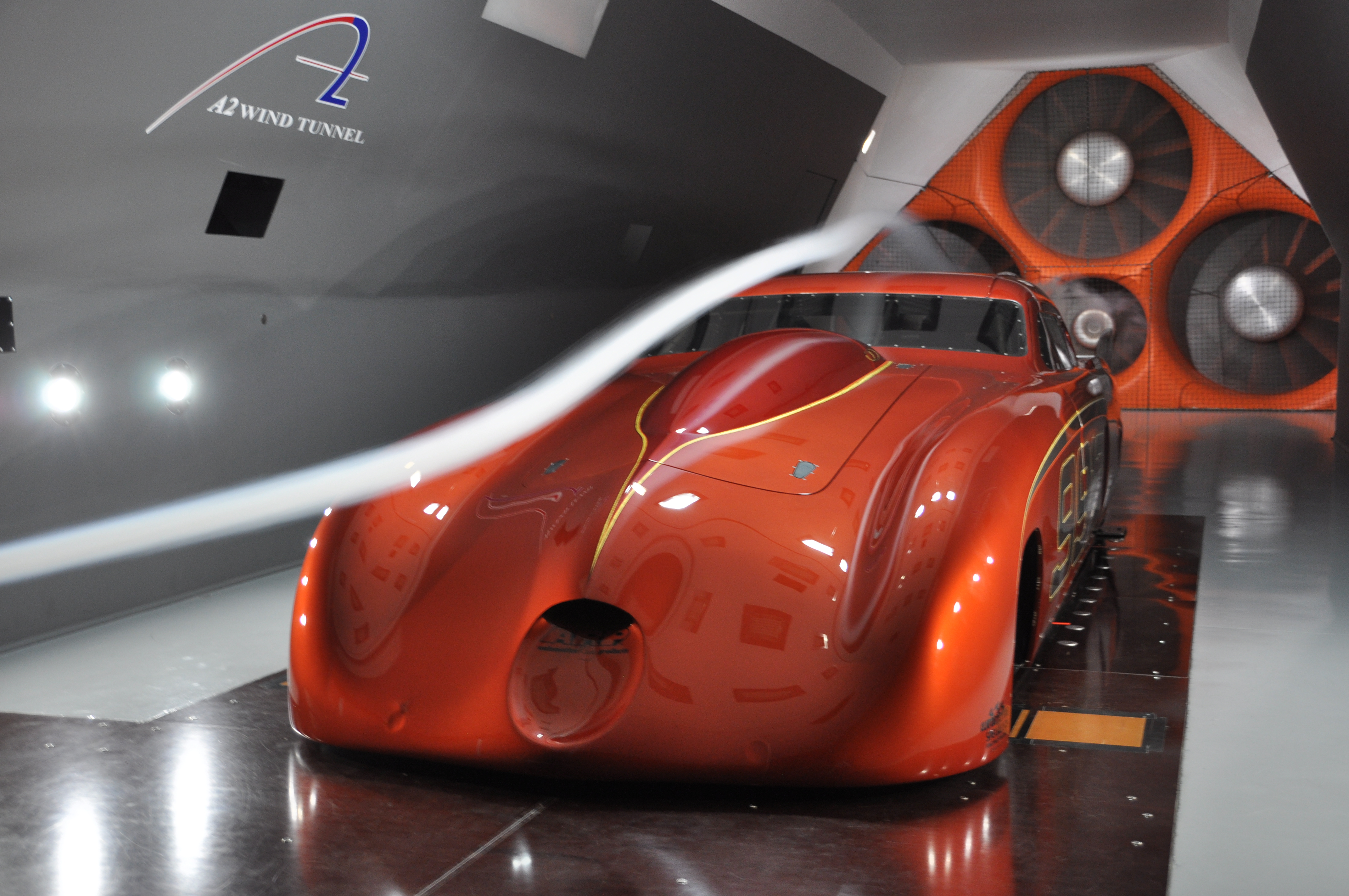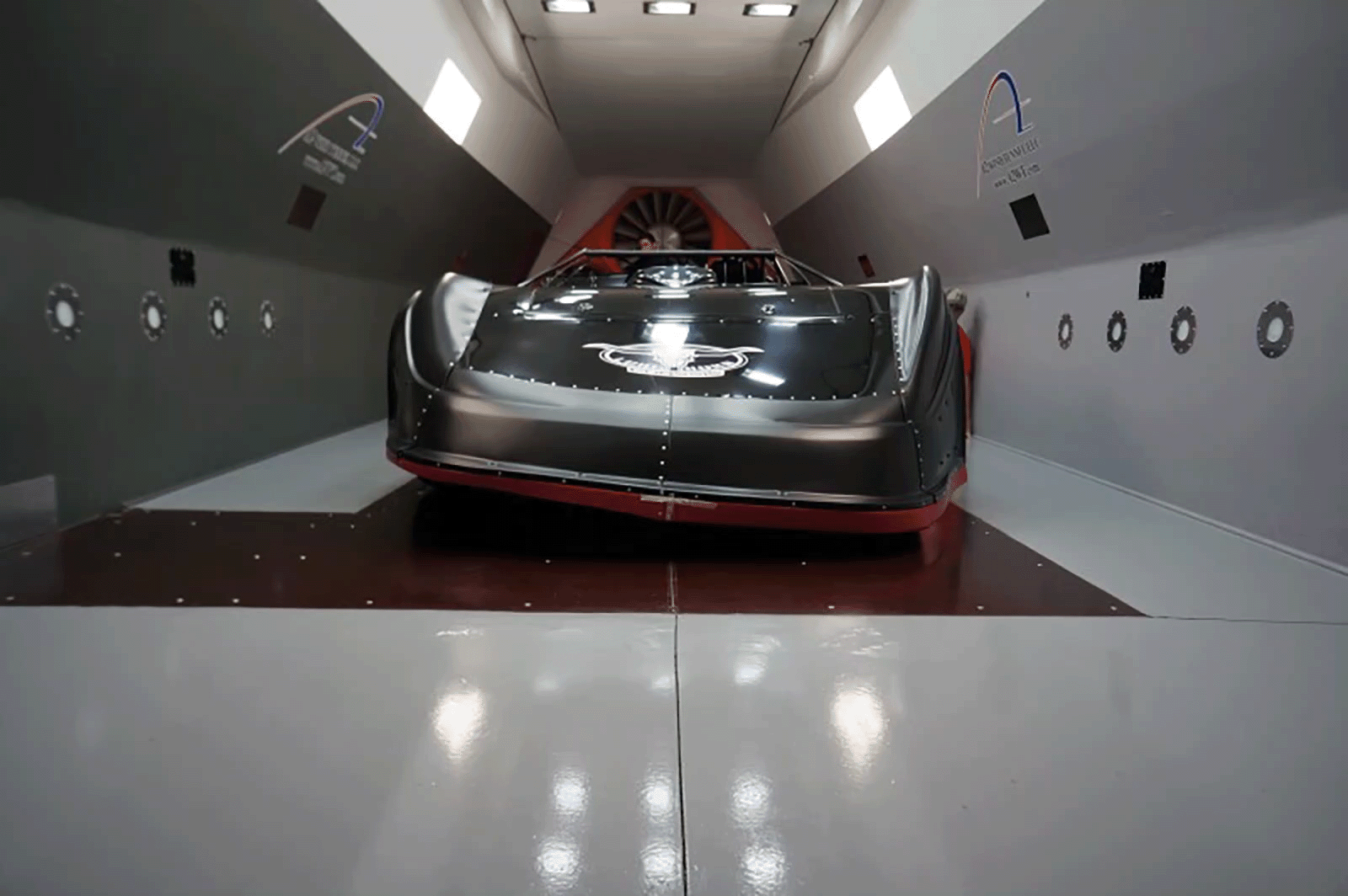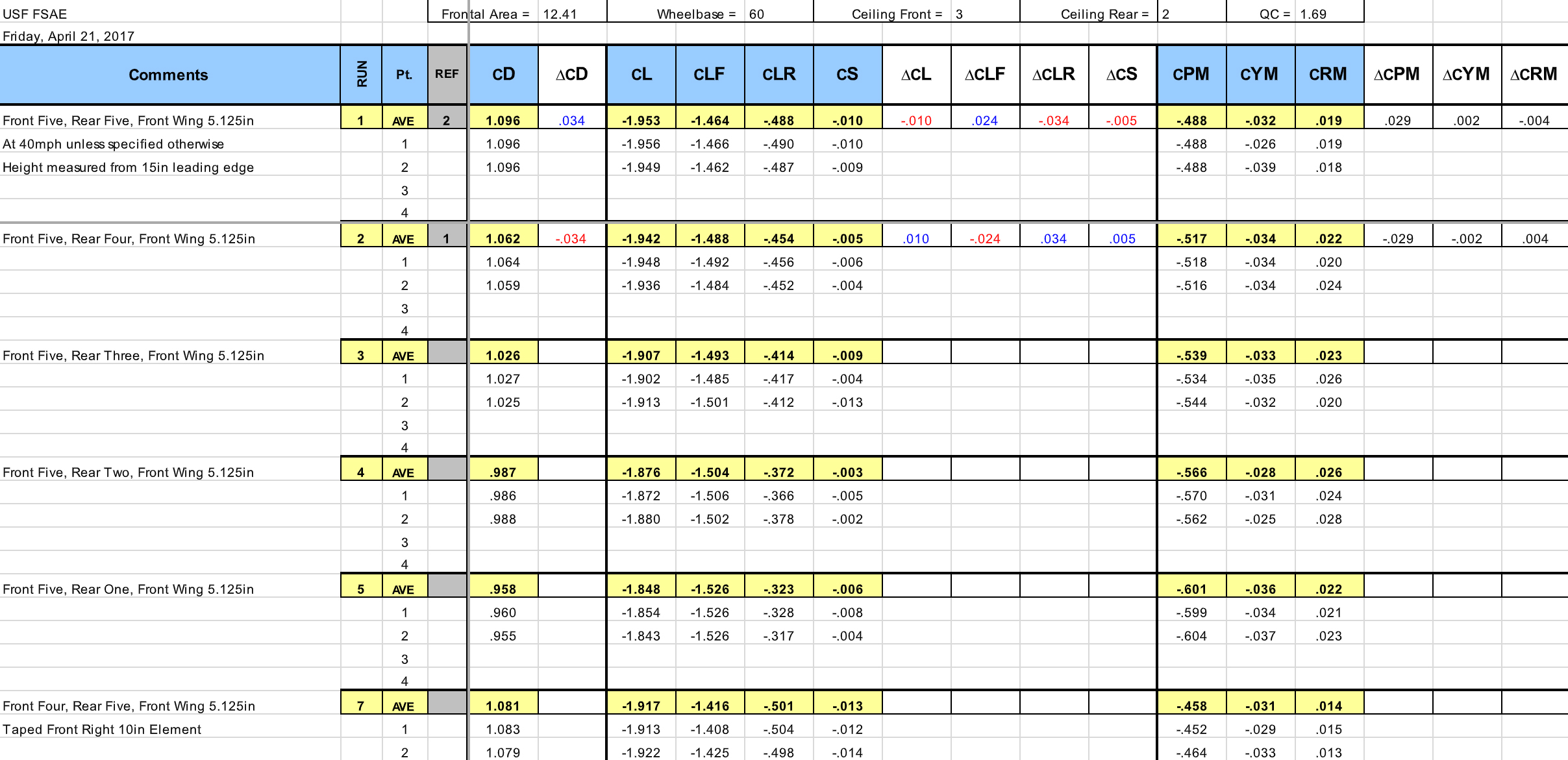
Full-scale, High Precision
Automotive Wind Tunnel
Motorsports Pricing & FAQ
General Pricing - $595/hr
With motor sports there are normally 2 things that will bring you to our wind tunnel, drag reduction and downforce.
When considering drag reduction one metric we use is horsepower of drag. If we can reduce the horsepower your vehicle requires to go a given speed that would be the equivalent of giving your engine that much more horsepower. How much time and money would you invest in dyno runs to gain 5, 10, 20, or even 100 or more horsepower in some cases? With your engine and rulebook would it even be possible with engine work? We can help there.
Downforce is critical for traction which translates to better handling and more power connecting with the track. But downforce is tricky to evaluate. There are really only 2 ways you can measure the amount of downforce you are generating, track testing and wind tunnel testing. Where track testing is concerned you either rely on driver feedback or invest in a very expensive data acquisition system installed on your vehicle. Both of which are effected by weather conditions, suspension and geometry among other things.We remove all the extra variables allowing you to find out exactly what forces your aero modifications are generating.
There is not a single top tier motor sports team that does not rely on wind tunnel testing for answers.
A2 Wind Tunnel is capable of measuring:
Drag
Total Lift / Downforce
Total Lift / Downforce
Total Lift / Downforce
Yaw Moment
Pitch Moment
Roll Moment
6 Dynamic Pressures
16 Static Pressures
We can accommodate vehicles with a frontal area up to approximately 30 square feet, a wheel base up to 230 inches, and track up to 80 inches. In special cases accommodations have been made for larger vehicles.
In simple terms frontal area is the visible area of the vehicle when viewed from straight ahead and for our uses is expressed in square feet. This number is an important variable in calculating the forces on your vehicle. A quick way to estimate the frontal area of a car is to multiply maximum height by maximum width and multiply by about 0.8 to compensate for those areas of the car that are shorter or narrower than those maximum dimensions.

Data is gathered and averaged over 77 seconds per data point. At least 2 data points averages are taken each run to confirm stability. At the end of each data collection point the data will populate on your excel spreadsheet. Data is expressed in Coefficients but also translated into Horsepower and Pounds at any user defined speed on the spreadsheet. At the end of testing we will send you a copy of the spreadsheet and photos coinciding with each run for visual reference. Follow this link for an example of a test spreadsheet and associated photos.
We recognize at A2 there are many first-time users, so we are available to help you through the testing process and some analysis of the data, helping to make the most use of your tunnel time. We do not develop your vehicle, as this could lead to technology transfer between competing teams, but we will help you understand how each change affects the vehicle (good or bad). Your information and data are proprietary to your test and nothing you learn will be told to other teams.
There are independent aero engineers who can consult (for a fee) at a more detailed level. If available, we will provide you with a consultant's contact information. Beyond contact information A2 will not be a party to any arrangements made between your team and the consultant.
If your date is flexible we usually have nearly immediate availability. However if you have a specific date in mind we recommend booking at least a month in advance.
A2 has a 2 hour minimum for testing. Our tunnel has been designed for quick turn-around, we typically make 4-6 runs per hour, depending upon how quickly the changes are made. Each run takes approximately 5 minutes. Installation time is billed which typically takes about 5 to 10 minutes. You are allotted up to 30 minutes before and after testing for prep and tear down.
Check
Visa
Mastercard
Discover
American Express
Cash
Every racing series is unique, you will need to know the rules that affect your vehicle's aero.
Many first time wind tunnel users may think they don't know where to start with aero development. Upon evaluation they generally realize they have already been working on aero development on track based on track times and driver feedback. It is best to work off of that experience. We suggest tunnel testing any critical modifications rather than assuming track times and driver feedback tell the full story as there are often other variables that may have played a part in those observations. One of the major benefits of wind tunnel testing is the ability to limit the variables to focus on aerodynamics.
We suggest fabricating quickly interchangeable parts for wind tunnel testing. These parts do not need to be race ready but should be as close to the correct shape as possible. At the tunnel we often use materials such as cardboard and duct tape to mock up parts for tunnel testing. Whenever possible we suggest mounting parts in advance as it is generally much quicker to remove parts than to attach them.
Every car MUST have working brakes or some other way to lock wheel rotation. If your wheels rotate during testing the system will measure more weight on the rear giving you false front to rear downforce balance.
Your car will be mounted in the tunnel with the rear tires resting on pads approximately 1/2" above the floor. Adjust your rear ride height 1/2" low to compensate. We recommend verifying ride height measurements once the car in mounted in the tunnel.
Bring all tools necessary to make changes and modifications to vehicle. This includes any power tools needed (drills, saws, etc.). A2 has a small shear and 90° sheet metal break but you need to bring any sheet metal you are planning to use.
It is always a good idea to bring extra material for modifications. Sometimes you discover a sensitive area, and extra material allows you to fabricate a change that was not originally planned.
Vehicles are rolled into the tunnel where the tires will rest on pads that are mounted to the balance. Rear wheels will sit approximately 1/2 inch above the floor, you should lower the rear of your vehicle 1/2 inch to compensate. Front wheels are strapped to the pads as a safety. Your brakes must be functional as they will be used to hold your car in position.
A2 can produce wind speeds ranging from 0 to 85 miles per hour. If your vehicle is planned to travel over 85 mph the forces in most cases can easily be scaled up. In some rare cases due to deflections or Reynolds number sensitivity forces may not scale accurately.
The boundary layer at A2, much like most wind tunnels in existence, is not a rolling road and simply has a passive boundary layer treatment by means of a ramp leading into the test section. This means under-body testing will have limited accuracy but in most cases bear useful results.
A2 has one smoke wand available for use. We also have a fluid that can be applied to surfaces that will create streaks in moving air to show an approximate surface airflow path. Yarn tufts may also be utilized to visualize surface air flow direction.
A2 has 16 pressure transducers available. In order to utilize these pressure transducers you must prep your car in advance with 1/16 i.d. rubber tubing 10 to 15 feet long.
A2 also has several air flow measuring devices known as anemometers available.
If you intend on utilizing either of these please read the detailed directions below.
The radiator anemometers available are a grid of tubes that will give us an average pressure (that can be used to calculate flow) across the area of the grid. In order to use the grid we will have to be able to access the rear of the radiator with about 1” of clearance across the entire face of the radiator AND a direct shot to the radiator that will allow us to maneuver the anemometer in to place.
Radiator anemometer sizes include:
6” x 9.5”
12” x 18”
14.5” x 23”
17” x 23”
A2 also has 2 large tube anemometers that can be spliced in line with brake ducts and the like. They measure 3” in diameter and 3.25” in depth.
Pressure taps are different as we cannot calculate a flow using these numbers they will merely be static pressures. Surface pressure taps are installed in advance and require 1/16” holes drilled in the surface where you would like a pressure measured and 1-2” of 1/16” metal tube carefully glued flush in the hole extending out of the non-measured side of the surface. 1/16th OD metal tubing usually can be purchased at your local hobby shop or online. Recommended glues include “plastic welder” or epoxy putty. When drilling these holes and installing the tubes it is imperative the hole be absolutely smooth with no burs or blockage. A good rule of thumb is that if you gently run your finger over it and you can feel any variation, it’s not smooth enough. We would then attach rubber tubing that will run from our data acquisition to the back side of your pressure taps.
If you are looking for static pressure in something like an airbox we recommend making a small manifold or chamber with many holes in different directions that will be fit with a tube feeding to the pressure transducers. This will minimize the effects of any flow directionality on the pressure. In a pinch you can make something simple like a water bottle, covered with holes and feed a tube into it.
All pressure readings will be averaged over the entire length of one tunnel run and will be displayed in line with the rest of your data on the Excel sheet.
Due to A2's advanced design with a limited cross sectional area we do not normally recommend testing at yaw. However in some very limited cases we may be able to test your vehicle at a slight yaw angle with limited accuracy.
You're scheduled time is your time of arrival. If you show up prior to your scheduled arrival time the tunnel may not be available for entry.
All vehicles will unload in our “A” garage in front of the building. You may temporarily park in front of the garage to unload vehicles, tools and parts, but you must then move the rig to a designated parking spot. The access road must remain open at all times for through traffic.
![]() A2 parking locations for cars, trucks, trailers, haulers
A2 parking locations for cars, trucks, trailers, haulers
![]() Parking reserved for Centroid and Aerodyn Wind Tunnel
Parking reserved for Centroid and Aerodyn Wind Tunnel

A cancellation fee will be assessed for cancellations with less than a 7 day advance notice.The charge for cancelling 4 hours or less of scheduled tunnel time will be $250. The charge for cancelling more than 4 hours of scheduled tunnel time will be $500 per day of cancelled tunnel time.

